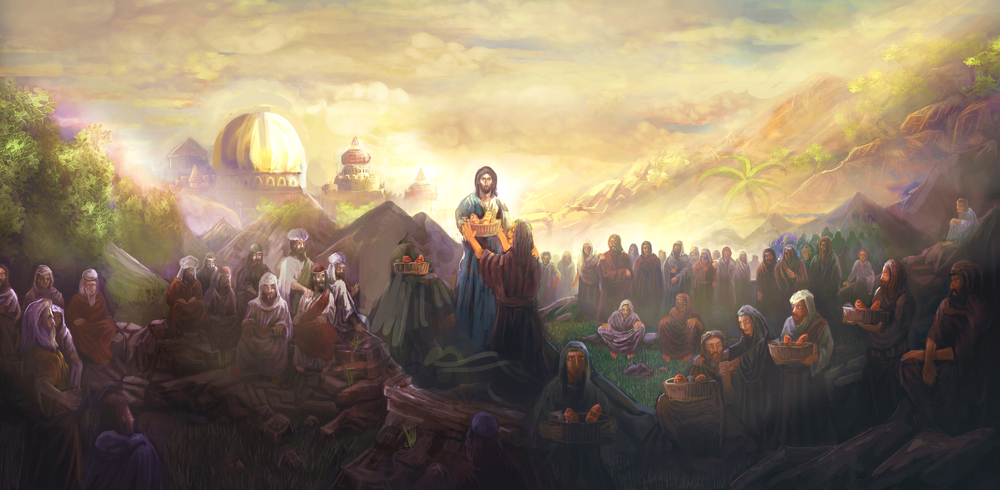This post is part of an ongoing series in the study of John we are doing during January. Subscribe to the blog for daily updates in the Bible Study posts. Subscribe to the podcasts to hear our discussion of the book of John throughout this month. Join us in your daily devotions as we travel through this fascinating account of the life of Christ.
***
After these things Jesus went over the Sea of Galilee, which is the Sea of Tiberias. Then a great multitude followed Him, because they saw His signs which He performed on those who were diseased. And Jesus went up on the mountain, and there He sat with His disciples. Now the Passover, a feast of the Jews, was near. Then Jesus lifted up His eyes, and seeing a great multitude coming toward Him, He said to Philip, “Where shall we buy bread, that these may eat?” But this He said to test him, for He Himself knew what He would do. Philip answered Him, “Two hundred denarii worth of bread is not sufficient for them, that every one of them may have a little.” One of His disciples, Andrew, Simon Peter’s brother, said to Him, “There is a lad here who has five barley loaves and two small fish, but what are they among so many?” Then Jesus said, “Make the people sit down.” Now there was much grass in the place. So the men sat down, in number about five thousand. And Jesus took the loaves, and when He had given thanks He distributed them to the disciples, and the disciples to those sitting down; and likewise of the fish, as much as they wanted. So when they were filled, He said to His disciples, “Gather up the fragments that remain, so that nothing is lost.” Therefore they gathered them up, and filled twelve baskets with the fragments of the five barley loaves which were left over by those who had eaten. Then those men, when they had seen the sign that Jesus did, said, “This is truly the Prophet who is to come into the world.” Therefore when Jesus perceived that they were about to come and take Him by force to make Him king, He departed again to the mountain by Himself alone. John 6:1-15 (NKJV)
We need to begin our study of this passage by realizing there were more than 5,000 people fed at this miraculous event and the fourth sign that Jesus performed. Verse 10 says there were about five thousand men. That did not count the women and children in the gathering. Scholars estimate the number of people in this throng could have numbered between 15,000 and 20,000.
Six months to one year have passed since the events in chapter five. The crowds following Jesus have become immense. A legitimate movement has formed around Him as people were drawn by the signs and miracles He performed. No doubt there was a lot of whispering and talk about this miracle worker who healed the sick, spoke in mysterious teachings (like a prophet), and challenged the authorities. Verse 4 says the Passover was near, which undoubtedly added to the nationalistic fervor and excitement regarding who this Man might be and what He might do in Israel.
Once again, we must shake off our familiarity with these stories and events recorded in the book of John and imagine ourselves living in those moments to grasp what is taking shape here. This is a formerly proud people living under subjection and occupation by a brutal colonizer force, the Roman army. The lives of the Jewish people are full of hardship, struggle, and oppression. Their only unifying respite is a look to the past and who they once were, or a hope for the future and the great prophecies that told of One who would come and redeem them and their former glory.
Is He the One?
As Jesus performed one miraculous sign after another (remember there were many of these signs not recorded in John’s gospel according to John 21:25), rumors spread. Excitement began to grow. Could He be the Promised One? If a man could heal the lame, the blind, and the sick, then how could the Roman army defeat Him? If He could miraculously feed thousands of people, what limitations could any force impose upon Him as a military or political leader? Was this the Messiah? Was God about to restore Israel?
Knowing the Heart of Men
But Jesus knew what was in the heart of men. Trust and faith won by miracles and signs would only be kept by miracles and signs. Most of these thousands who followed Him found excitement and entertainment, but their heart was not changing. They did not believe from the heart. Only a tiny circle of His followers, the true disciples, were mustering a faith that stretched beyond the outward spectacle and into the inner heart.
Although the masses benefitted from these mighty works and miracles, Jesus was most interested in the effect such acts had upon His true disciples. The limits of Phillip’s faith stretched from the beginning of this miracle to its conclusion. The disciple who could not fathom a way to meet the needs of so great a crowd began to realize that nothing was impossible for the Son of God.
He Withdrew
After this powerful sign of God, Jesus withdrew from the crowd to the mountain by Himself. He knew they wanted to make Him king. He came to earth as the King of kings, but His coronation was different from what the people had in mind.
Those who knew Jesus and experienced His reality in spirit and truth were those whose faith and devotion went beyond the signs and miracles. They did not see the Christ they expected to see. They beheld the glory of the Son of God, an unveiling they never imagined possible.
The boxes and definitions we often try to force Christ into only end in His withdrawal. He wants a change of heart, faithful followers who see Him and follow Him beyond the spectacle. These are the lifelong commitments that move with Christ in the highs and lows, learning and becoming as we grow with Him.
Subscribe to the blog as we continue our walk through the book of John tomorrow.
[email-subscribers-form id=”2″]





What do you think?
Show comments / Leave a comment